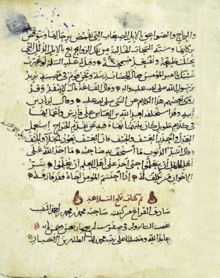Nahj al-Balāgha
Nahj al-Balāgha ( Arabic نهج البلاغة, DMG Nahǧ al-balāġa 'Path of Eloquence') is an important Shiite book with the character of a hadith collection . It contains a selection of the speeches, letters and words of Ali ibn Abi Talib , the son-in-law of the Prophet Mohammed , fourth caliph and first Imam of the Shiites . The work was compiled by Sharif ar-Radi (around 970-1016), with a view to the uniqueness of the oratory and rhetoric.
It deals with various fundamental issues of Islam that are now also of political relevance for countries like Iran . Including topics such as theology, the world of angels, the creation of the universe, human nature, the position of women and what a good Islamic government should look like.
It is divided into three sections: Part one mainly contains 241 talks ( chutba ) by Imam Ali, Part Two the letters Ali wrote to friends and enemies, to deputies, government officials and military commanders, etc., a total of 79 letters. Part three comprises 480 maxims.
expenditure
- Abu al-Hasan Muhammad b. Musa Sayyid Radi : Nahju'l-Balágha: The Open Road of Eloquence (containing discourses attributed to Ạli), lithographed in Meshed, 1892
Translations
The work was translated into Persian by Mulla Fathulla and into German by Fatima Özoğuz (Sharif Radhi Muhammad ibn Hussain: Nahdsch-ul-Balagha. Path of Eloquence , in two volumes, Eslamica: Bremen, 2007. ISBN 978-3-939416-10 -4 ).
Web links
References and footnotes
- ↑ Netton, Richard: Encyclopaedia of Islam . Routledge, 2007, ISBN 978-0-7007-1588-6 .
- ^ Oxford Islamic Studies online
- ↑ german.irib.ir: The Islamic Culture and Civilization in the Course of History (Part 55) ( Memento of the original from November 6, 2012 in the Internet Archive ) Info: The archive link was automatically inserted and not yet checked. Please check the original and archive link according to the instructions and then remove this notice. ( Broadcast manuscript of the Broadcasting Corporation of the Islamic Republic of Iran from May 21, 2012)
- ^ After Dwight M. Donaldson : Shi'ite Religion (London, 1933), p. 373, there with the indication: 1073
- ^ Donaldson, p. 375
